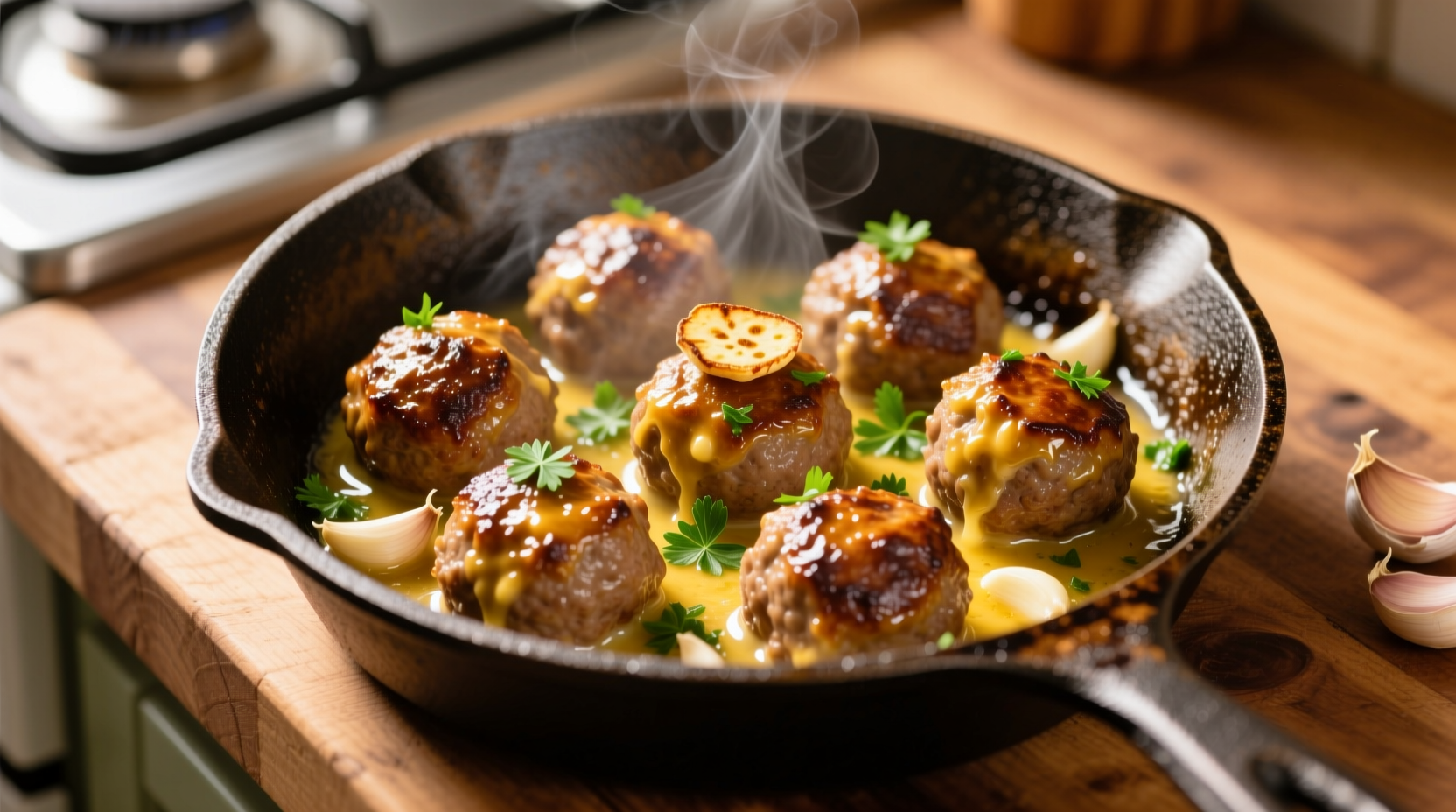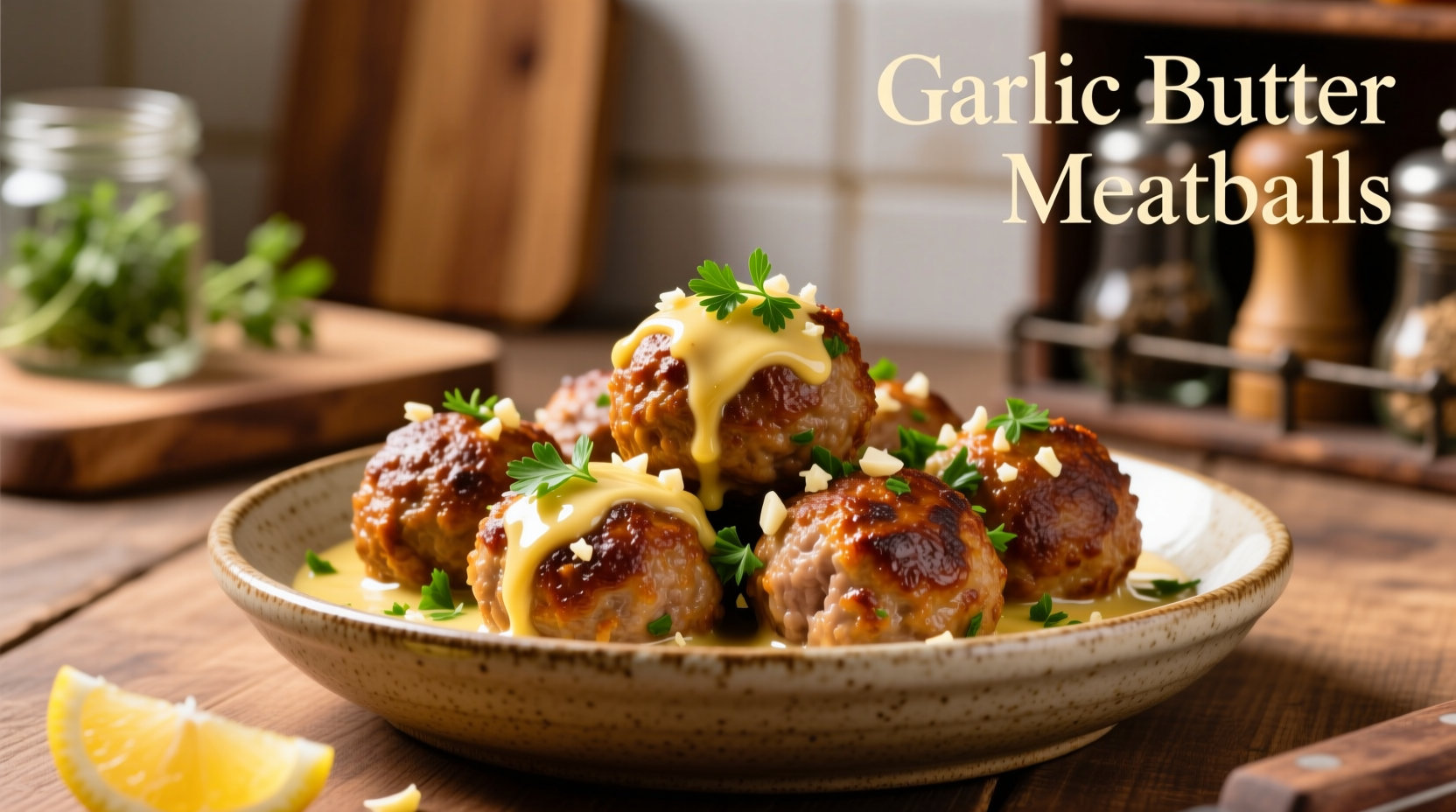Searching for the perfect garlic butter meatballs recipe? You've found it. This guide delivers a foolproof method for creating meatballs that are tender on the inside, beautifully seared on the outside, and coated in a luxurious garlic butter sauce that elevates this classic comfort food. Whether you're preparing a quick weeknight dinner or entertaining guests, these meatballs deliver maximum flavor with minimal fuss.
Why This Garlic Butter Meatballs Recipe Works
Professional chefs know that the magic happens at the intersection of proper technique and quality ingredients. Unlike many recipes that drown meatballs in sauce, this method focuses on building flavor at each stage. The garlic butter isn't just a topping—it's a finishing technique that preserves the meatballs' texture while adding aromatic complexity.
Essential Ingredients and Why They Matter
The foundation of exceptional garlic butter meatballs lies in ingredient selection and balance. Here's what you need and why each component matters:
| Ingredient | Function | Pro Tip |
|---|---|---|
| 85% lean ground beef | Provides rich flavor and proper fat content | Mix with 15% ground pork for enhanced juiciness |
| Fresh garlic (minced) | Creates aromatic foundation without bitterness | Add half during cooking, half at the end for layered flavor |
| Unsalted butter | Carries garlic flavor and creates glossy finish | Use European-style butter (82% fat) for richer results |
| Parmesan cheese | Enhances umami and helps bind ingredients | Always use freshly grated, never pre-grated |
Step-by-Step Preparation Guide
Meatball Formation: The Critical First Step
Proper meatball formation determines texture. Follow these steps for consistent results:
- Chill all ingredients before mixing (including your hands)
- Use a kitchen scale for uniform 1.5 oz portions (about 1.5 inches diameter)
- Gently form balls without overworking the meat
- Refrigerate formed meatballs for 30 minutes before cooking
Cooking Method: Achieving Perfect Texture
The cooking technique makes all the difference between tough and tender meatballs:
- Heat 2 tablespoons oil in cast-iron skillet over medium-high heat
- Sear meatballs in single layer without crowding (work in batches)
- Rotate frequently for even browning on all sides (about 8-10 minutes total)
- Remove when internal temperature reaches 155°F (they'll finish cooking in sauce)
Garlic Butter Sauce: The Flavor Elevator
This isn't just melted butter with garlic—it's a carefully balanced finishing sauce:
- Reduce heat to medium and add 4 tablespoons unsalted butter
- Add 4 minced garlic cloves and cook 1-2 minutes until fragrant but not browned
- Stir in 2 tablespoons fresh parsley and 1 teaspoon lemon zest
- Return meatballs to pan and coat thoroughly for 2 minutes
- Finish with flaky sea salt to enhance all flavors

Global Meatball Traditions Timeline
Meatballs have evolved across cultures with distinct preparation methods. Understanding this history helps appreciate why certain techniques work best:
| Era | Region | Key Development | Modern Application |
|---|---|---|---|
| 2nd Century | Roman Empire | "Isicia Omentata"—early meat patties with wine and pine nuts | Binding agents and flavor enhancers concept |
| 13th Century | Persia | "Kofta" preparation with spices and herbs | Seasoning techniques still used today |
| 18th Century | Sweden | "Köttbullar" with cream sauce | Garlic butter concept evolution |
| 20th Century | United States | Italian-American "Sunday gravy" tradition | Modern garlic butter meatball fusion |
Proven Cooking Techniques for Better Results
Based on food science research from the USDA Food Safety and Inspection Service, these techniques ensure perfect meatballs every time:
Temperature Control is Crucial
Meat proteins begin to contract at 120°F, squeezing out moisture. The ideal internal temperature for beef meatballs is 155-160°F. Cooking beyond this point results in dry, tough meatballs. Use an instant-read thermometer for accuracy.
Butter Chemistry Matters
According to research published in the Journal of Agricultural and Food Chemistry, butter's milk solids caramelize at 250-300°F, creating complex flavor compounds. This is why we add garlic to melted butter rather than cooking them together from cold—precise temperature control prevents bitter, burnt garlic.
Variations and Serving Suggestions
While classic garlic butter meatballs shine on their own, these variations work well for different occasions:
- Weeknight Dinner: Serve over egg noodles with steamed broccoli
- Appetizer Version: Make smaller (1 oz) portions and serve with toothpicks
- Dietary Adaptation: Use ground turkey and olive oil for lighter version
- Flavor Boost: Add 1 teaspoon red pepper flakes to the garlic butter
Storage and Reheating Guidelines
Proper storage maintains texture and flavor. Following guidelines from the FDA Food Code:
- Refrigerate within 2 hours of cooking
- Store in airtight container for up to 3-4 days
- Freeze for up to 3 months (without sauce)
- Reheat gently in skillet with additional butter to restore moisture
Frequently Asked Questions
Can I make garlic butter meatballs ahead of time?
Yes, you can prepare meatballs up to 24 hours in advance. Form and refrigerate them on a parchment-lined tray. For best results, sear just before serving and finish with fresh garlic butter. Cooked meatballs can be stored refrigerated for 3-4 days following FDA food safety guidelines.
Why do my meatballs fall apart when cooking?
Meatballs typically fall apart due to improper binding. Use 1/4 cup breadcrumbs per pound of meat and one egg. Avoid overmixing—combine ingredients just until incorporated. Chilling formed meatballs for 30 minutes before cooking helps them maintain shape during searing.
What's the best way to prevent dry meatballs?
Maintain proper fat content (aim for 15-20% fat in your ground meat), avoid overcooking (remove at 155°F), and don't overmix the ingredients. Adding 2 tablespoons of milk or cream to the mixture helps retain moisture during cooking. The garlic butter finish also creates a protective layer that seals in juices.
Can I use dried garlic instead of fresh?
While fresh garlic provides superior flavor, you can substitute 1 teaspoon garlic powder for each clove of fresh garlic. Add dried garlic to the meat mixture rather than the butter, as it burns easily. For best results, rehydrate dried garlic in 1 tablespoon warm water before adding to the meat mixture.
How do I make gluten-free garlic butter meatballs?
Replace traditional breadcrumbs with 1/4 cup almond flour or gluten-free panko per pound of meat. Ensure your Parmesan cheese is gluten-free (some brands add anti-caking agents with gluten). The cooking method remains identical, but check meatballs more frequently as almond flour browns faster.











 浙公网安备
33010002000092号
浙公网安备
33010002000092号 浙B2-20120091-4
浙B2-20120091-4